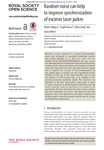Random noise can help to improve synchronization of excimer laser pulses
| dc.contributor.author | Mingesz, Róbert | en_US |
| dc.contributor.author | Barna, Angéla | en_US |
| dc.contributor.author | Gingl, Zoltán | en_US |
| dc.date.accessioned | 2016-10-11T05:37:21Z | |
| dc.date.available | 2016-10-11T05:37:21Z | |
| dc.date.issued | 2016 | en_US |
| dc.identifier.other | HPU4160681 | en_US |
| dc.identifier.uri | https://lib.hpu.edu.vn/handle/123456789/23573 | |
| dc.description.abstract | Recently, we have reported on a compact microcontroller-based unit developed to accurately synchronize excimer laser pulses (Mingesz et al. 2012 Fluct. Noise Lett. 11, 1240007 (doi:10.1142/S021947751240007X)). We have shown that dithering based on random jitter noise plus pseudorandom numbers can be used in the digital control system to radically reduce the long-term drift of the laser pulse from the trigger and to improve the accuracy of the synchronization. In this update paper, we present our new experimental results obtained by the use of the delay-controller unit to tune the timing of a KrF excimer laser as an addition to our previous numerical simulation results. | en_US |
| dc.format.extent | 5 p. | en_US |
| dc.format.mimetype | application/pdf | |
| dc.language.iso | en | en_US |
| dc.subject | Engineering | en_US |
| dc.subject | Electrical engineering | en_US |
| dc.subject | Active timing control | en_US |
| dc.subject | Jitter noise | en_US |
| dc.subject | Dithering | en_US |
| dc.subject | Programmable delay | en_US |
| dc.subject | Excimer laser | en_US |
| dc.title | Random noise can help to improve synchronization of excimer laser pulses | en_US |
| dc.type | Article | en_US |
| dc.size | 448KB | en_US |
| dc.department | Education | en_US |
Files in this item
This item appears in the following Collection(s)
-
Education [806]

